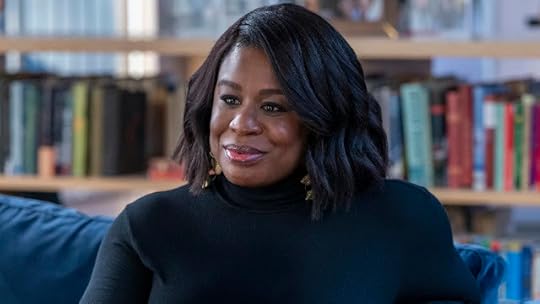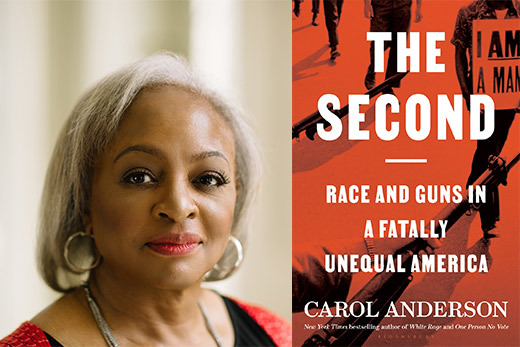Mark Anthony Neal's Blog, page 203
July 1, 2021
Writing the Future: BASQUIAT and the Hip Hop Generation at the MFA Boston

'Artists Fab 5 Freddy, Futura, Lee Quiñones, Lady Pink are in conversation with moderator and curator Liz Munsell in honor of the Museum of Fine Arts, Boston's landmark exhibition Writing the Future: Basquiat and the Hip-Hop Generation.' -- Sotheby's
Actor Colman Domingo Tapped into Something Sinister for "Zola"

'The new movie Zola opened in theaters. Based on a viral Twitter thread by A'Ziah King from 2015, the film tells the story of two sex workers who go on a road trip from hell. The movie is directed by Janicza Bravo and co-written by Bravo and Jeremy O. Harris. Actor Colman Domingo stars in the movie as an intimidating pimp, somewhat of a departure from the compassionate figures he’s played in movies like If Beale Street Could Talk in recent years. Domingo will also be starring later this summer in Nia DaCosta and Jordan Peele’s Candyman sequel. Today, Domingo joins The Takeaway to discuss his impressive career.'
Smithsonian Anthology of Hip-Hop and Rap

'The Smithsonian’s National Museum of African American History and Culture (NMAAHC) has partnered with Smithsonian Folkways Recordings to produce the Smithsonian Anthology of Hip-Hop and Rap to be released Aug. 20. This first-of-its-kind collection chronicles hip-hop’s growth and impact from the parks of the Bronx to the broadest areas of the American experience and worldwide influence. A track list and additional information about the anthology are available, including images from the set.
“Born in Bronx and raised across the American West and South, hip-hop is one of the most influential genres of music in the modern era,” said Kevin Young, the Andrew W. Mellon Director of NMAAHC. “Through beats, dynamic rhymes and pointed lyricism, hip-hop has provided a platform for communities and generations to voice their ongoing struggles and has changed society and culture around the world.”
The project is the latest in the Smithsonian African American Legacy Series, a collaboration between Smithsonian Folkways and NMAAHC to tell stories about music by African Americans and the experiences that inspire it. The launch of the anthology comes as the museum prepares to celebrate its five-year anniversary and highlights its ongoing mission to tell the stories of American history through the African American lens. The anthology details the evolution of hip-hop over four decades through 129 tracks spread across nine CDs, along with a 300-page coffee table book featuring 11 essays from prominent music scholars, authors and journalists covering topics such as entrepreneurship, graffiti, women in hip-hop and more, as well as extensive notes on each track.
“We wanted the Smithsonian Anthology of Hip-Hop and Rap to be reflective of the culture, of the music, of the people, of everything that is part of hip-hop,” said Dwandalyn R. Reece, NMAAHC’s associate director for curatorial affairs, curator of music and performing arts and producer of the anthology.
In addition, the anthology features hundreds of photographs spanning decades of history. It was designed by artist Cey Adams, founding creative director of Def Jam.
In hip-hop’s early years, some critics refused to acknowledge the art form as music, dismissing it instead as unoriginal and uncreative. As a result, hip-hop spent its first decade of growth as a niche genre that much of the music industry assumed would burn out in a short time. Now, as hip-hop nears its 50th anniversary, it is the most popular musical genre in the U.S., with notable influence and impact in all aspects of American culture. Arguably one of the last music counter cultures, hip-hop is instrumental in shaping and narrating the stories of America’s inner cities.
The Anthology of Hip-Hop and Rap is a thoroughly researched and thoughtfully curated set of essays that tell the story of hip-hop and rap, acting as an extension of the museum’s permanent collections. The project was produced over seven years from launch to completion, with the care and intention befitting the weight and scope of hip-hop’s story. The work began in 2014 from an executive committee composed of key figures in the music and culture of hip-hop, including rappers Chuck D and MC Lyte; writers and scholars Adam Bradley, Jeff Chang, Cheryl Keyes and Mark Anthony Neal; early Def Jam senior executives-turned-cultural advisors Bill Adler and Bill Stephney; artist and writer Questlove; and producer and educator 9th Wonder. An additional panel of advisors was assembled with equal representation from all facets of hip-hop culture.
While music is the centerpiece, the anthology dives into the cultural impact of hip-hop and global influence. It is not a greatest-hits compilation but a narrative of hip-hop’s music, culture and legacy. Spanning musical eras from 1979–2013, the final collection of 129 songs is the first with music from all three major record companies: Sony, Universal and Warner. The anthology is a contextual education on hip-hop’s origin, social and cultural impact, commercial dominance and more. It follows other defining collections from Smithsonian Folkways, the Anthology of American Folk Music and Jazz: The Smithsonian Anthology.
About the National Museum of African American History and Culture
Since opening Sept. 24, 2016, the National Museum of African American History and Culture has welcomed more than 7 million visitors. Occupying a prominent location next to the Washington Monument on the National Mall in Washington, D.C., the nearly 400,000-square-foot museum is the nation’s largest and most comprehensive cultural destination devoted exclusively to exploring, documenting, and showcasing the African American story and its impact on American and world history. For more information about the museum, visit nmaahc.si.edu, follow @NMAAHC on Twitter, Facebook and Instagram, or call Smithsonian information at (202) 633-1000.
About Smithsonian Folkways
Smithsonian Folkways Recordings, the “National Museum of Sound,” makes available close to 60,000 tracks in physical and digital format as the nonprofit record label of the Smithsonian, with a reach of 80 million people per year. A division of the Smithsonian Center for Folklife and Cultural Heritage, the non-profit label is dedicated to supporting cultural diversity and increased understanding among people through the documentation, preservation, production and dissemination of sound. Its mission is the legacy of Moses Asch, who founded Folkways Records in 1948 to document “people’s music” from around the world. For more information about Smithsonian Folkways Recordings, visit folkways.si.edu.
# # #
June 29, 2021
Enlightened with Lisa Borders: Elizabeth Williams - Mechanics of Making a Difference

'The WNBA's Elizabeth Williams stops by Enlightened with Lisa Borders to talk about the often unmentioned humanity at the heart of the Black Lives Matter movement. From the Atlanta Dream to her own American dream, Elizabeth reverses her own history of hesitancy and shares her methodical evolution with social justice in the United States. Together, we follow her journey from quiet supporter, to marching on Centennial Park, to effectively standing up to her Senator and team's owner, to peacefully calling the bluff of the National Guard. She walks us through the inner workings of 'the shirt,' takes us behind the scenes of the 2020 Wubble, and lets us in on some league secrets around the detailed and disciplined mechanics of making a difference.'
Uncle Bobbie's Presents: Marlon Peterson's 'Bird Uncaged: An Abolitionist's Freedom Song'

'Uncle Bobbie's Coffee & Books's proudly welcomed author Marlon Peterson for an honest and highly anticipated discussion on his new book, Bird Uncaged: An Abolitionist's Freedom Song. He was joined in conversation by Regina Bradley, Kiese Laymon, and Akiba Solomon.'
Missing Chapter: How Radical Gardeners Took Back New York City

'New York City looked a lot different in the 1960s and 1970s. A sharp economic decline and white flight meant there was mass disinvestment and urban decay, particularly in the city’s lower-income neighborhoods. It’s what Hattie Carthan and Liz Christy noticed in their communities when they each set out to revive their neighborhoods by making them greener. Ultimately, their radical acts of gardening would transform the landscape across New York City.' -- Vox
June 28, 2021
How Uzo Aduba's Mom Helped Prepare Her To Play A Therapist 'In Treatment'

'After winning two Emmys for playing Suzanne "Crazy Eyes" Warren on Orange Is the New Black, Uzo Aduba says her current role as a psychotherapist in HBO's reboot of its In Treatment series is an exciting change. "If that's not a 180, I don't know what is!" Aduba says of the new role. Playing "Crazy Eyes" felt like "the funhouse mirror side of mental health," she explains. And Dr. Brooke Taylor is "on the opposite end." Aduba tells Fresh Air that her depiction of Dr. Taylor is inspired in part by her late mother, who was a great listener.'
U.S. Prepares to Reckon with Past Atrocities Against Indigenous Children

'For more than a century, hundreds of thousands of indigenous children were forcibly removed from their communities — and taken to boarding schools to assimilate in both the U.S. and Canada. Now, U.S. Interior Secretary Deb Haaland will be launching a new initiative investigating the quote “the loss of human life and the lasting consequences” of these schools. The Takeaway spoke to Nick Martin, staff writer for The New Republic and member of the Sappony tribe, about efforts to address this tragic history in the U.S. and Canada.'
The Lost Graves of Louisiana’s Enslaved People

'Historical maps. The descendants of enslaved people. And multibillion dollar petrochemical companies. These elements converge in a story about the hidden burial grounds of Louisiana’s enslaved people, and how continued industrial development is putting the historic sites at risk. In this New York Times video, we reveal what is hiding in plain sight: the possible burial grounds of enslaved people who were forced to work these plantations 200 years ago. Their locations have remained a mystery, until now. Using a new study from the research group Forensic Architecture, we looked at historical maps and aerial photos, drone footage, satellite imagery and went to Louisiana to find these concealed graves. Their research uses a technique called cartographic regression, which is used by archeologists to travel back in time to see how the land has changed. The research shows how even a single tree can be a crucial marker.'
Carol Anderson’s “The Second: Race and Guns in a Fatally Unequal America”

'Carol Anderson, whose previous work, White Rage, won the 2016 National Book Critics Circle Award, joins LARB Radio Hour to discuss her latest book, The Second: Race and Guns in a Fatally Unequal America. Anderson takes a long historical look at the emergence and development of the Second Amendment — “A well regulated Militia, being necessary to the security of a free State, the right of the people to keep and bear Arms, shall not be infringed” — in the context of anti-Black violence and public policy debates. Anderson reveals the various ways in which slavery — and, in particular, white slaveowners’ fears of insurrection — shaped the Second Amendment from the very beginning, with long-reaching effects that we continue to face today, a year after the murder of George Floyd by a white police officer. The infamous Amendment is premised on a racial divide: a white man wielding a gun receives Constitutional protections, while in the hands of a Black man in the United States, a firearm can so often be a death sentence.'
Mark Anthony Neal's Blog
- Mark Anthony Neal's profile
- 30 followers



